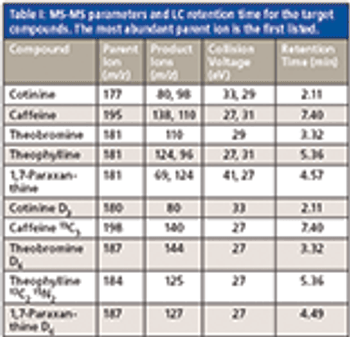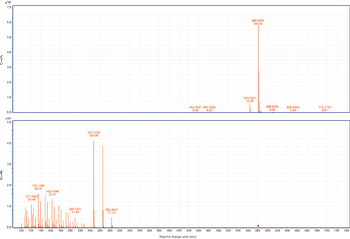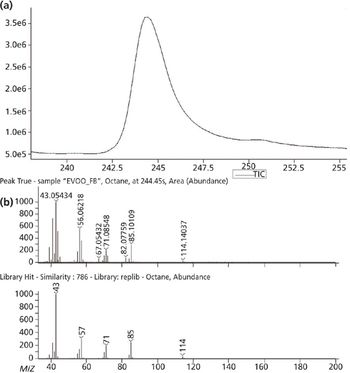
A multiresidue method has been developed and validated for the analysis of methylxanthines (caffeine and its metabolites) and cotinine in human plasma.


A multiresidue method has been developed and validated for the analysis of methylxanthines (caffeine and its metabolites) and cotinine in human plasma.

Click here to view the complete Wavelength newsletter from July 29, 2014.

This interview with Steven J. Ray, an Associate Scientist in the Department of Chemistry at Indiana University in Bloomington, Indiana, discusses his work with a new form of mass spectrometry (MS) for analyzing complex samples.

Military jet fuel (JP-8) is very similar to commercial jet fuel (Jet A) except for the presence of three additives, fuel system icing inhibitor, corrosion inhibitor–lubricity improver (CI-LI), and antistatic additive, which are added to improve characteristics of JP-8.

Direct sample analysis coupled to high-resolution time-of-flight mass spectrometry (TOF-MS) may be effective at analyzing synthetic cathinones, especially for qualitative analysis, because it does not require potentially tedious sample preparation.

Canola largely contains unsaturated fatty acids, thus rendering it clear in most cases after extraction and refining.

Simple, sensitive, rapid, selective, and precise reversed-phase liquid chromatography (LC), electrospray ionization mass spectrometry (ESI-MS), and tandem MS (ESI-MS-MS) methods were developed and validated for the determination of 2-hydroxy-4-(methylthio)-butanoic acid (HMTBA) in bovine serum and sea water matrix. HMTBA is the ?-hydroxy analog of the sulfur-containing amino acid methionine and is extensively used as a methionine supplement in poultry and bovine feed.

Native mass spectrometry, the method by which noncovalent protein complexes are retained in the gas phase for intact mass analysis, is gaining interest as a method for intact protein characterization. The development of a modified orbital ion trap platform for high-resolution analyses has expanded the role of native mass spectrometry to address the challenges of intact protein characterization.

Ionization of small, large, volatile, and nonvolatile compounds with charge states nearly identical to electrospray ionization are produced from a solid matrix or solution with high sensitivity utilizing the vacuum inherent with any mass spectrometer. With the proper matrix, analytes can be analyzed from ambient conditions or by direct introduction into vacuum.

The identification of nontargeted species in environmental and commercial samples by mass spectrometry can be very difficult. In this article, authors from Eastman Chemical Company describe their systematic approach for the identification of nontargeted species using nominal and accurate mass data, searching both mass spectral and "spectra-less" databases.

In this article, we examine how tandem and tandem hybrid mass spectrometry has opened up new frontiers already. We go further and examine how lesser-known experiments are breaking new ground, with alternative fragmentation techniques, as well as the addition of extra levels of orthogonality by parallel separations techniques.

Mass spectrometry is a powerful analytical tool. Yet researchers and instrument makers continue to push the limits of its resolving power. One such researcher is David E. Clemmer, the Robert & Marjorie Mann Chair and Distinguished Professor of Chemistry at Indiana University in Bloomington, Indiana and the 2014 Anachem Award winner. Clemmer's group has done extensive research to develop and improve ion trapping techniques and ion mobility spectrometry-mass spectrometry (IMS-MS) instruments to analyze biomolecular mixtures and structures.

The production and sale of counterfeit drugs has risen sharply in recent years. The World Health Organization (WHO) estimates that counterfeit medicines account for approximately 1% of sales in developed countries and well over 10% in developing countries.

Here, a method to characterize edible oils and edible oil mixtures through fingerprinting and the isolation of individual analyte differences is reported. Aroma and flavor analytes in extra virgin olive, olive, peanut, grapeseed, and vegetable oils were sampled with headspace solid-phase microextraction (HS-SPME).

Despite the advantages of soft ionization ion-source technologies for improving confidence in the identification of a range of challenging analytes, soft ionization remains a niche technique for gas chromatography–mass spectrometry (GC–MS).

Translational proteomics has not been as successful as originally anticipated. Because mass spectrometry (MS) can separate proteins at the sequence level, it provides the selectivity needed for this application; however, traditional challenges still exist, including time-to-result, throughput, and sample-size requirements.

Everyone loves a list, and the editors of Spectroscopy are no exception! In 2013, Spectroscopy covered a wide array of topics throughout the year to bring you the most relevant information for your work, on topics ranging from selecting the right ICP-MS system to deciding which Raman technique is right for you, from our annual salary survey to calibration transfer. Here is a list of 13 popular articles and columns from 2013

Guido F. Verbeck, an associate professor in the Department of Chemistry at the University of North Texas (Denton, Texas), has been developing a technique called direct analyte-probed nanoextraction (DAPNe). Verbeck is using DAPNe, coupled to nanospray ionization mass spectrometry (MS), in a variety of applications, including forensic analyses. Spectroscopy asked Verbeck about his work with this method and how it is used.

Some central transformative themes and their impact in modern analytical mass spectrometry are discussed, such as isotopic analysis, exact measurements, information processing, and more.

A review of the basics of ion mobility spectrometry and field-asymmetric ion mobility spectrometry (FAIMS), plus how to couple FAIMS to mass spectrometry

Spectroscopy recently spoke with Dr. Dominic Hare, a senior research officer at the Florey Institute of Neuroscience and Mental Health in Australia, about his work using laser ablation-inductively coupled plasma-mass spectrometry (LA-ICP-MS) to study metals in the brain. His research highlights the role that iron plays in Parkinson's disease in the hopes to better understand the causes of the disease and eventually find an appropriate treatment.

An interview with Charles Wilkins, the winner of the 2013 American Chemical Society Division of Analytical Chemistry Award in Chemical Instrumentation, sponsored by the Dow Chemical Company.

A study of pharmaceuticals and personal care products in river water samples is presented from northeastern United States using ultrahigh-pressure liquid chromatography (UHPLC) coupled with TOF-MS for both targeted and nontargeted analytes

The method development process required for the accurate quantification of both clopidogrel and its acid metabolite with a lower limit of quantification (LLOQ) of 1 pg/mL in human plasma is discussed.

This article examines the various effects of phospholipids in liquid chromatography tandem mass spectrometry (LC–MS-MS) analysis and demonstrates a new phospholipid-removal approach.